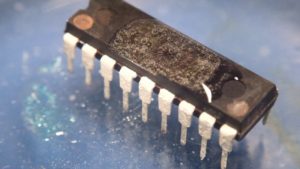Crack MCU PIC18F2321 Heximal
Crack MCU PIC18F2321 and copy its embedded Heximal out from the memory which include the program of flash and data of eeprom, then rewrite the firmware into other blank Microcontroller PIC18F2321 for an exact Microcontroller cloning;

Crack MCU PIC18F2321 and copy its embedded Heximal out from the memory which include the program of flash and data of eeprom, then rewrite the firmware into other blank Microcontroller PIC18F2321 for an exact Microcontroller cloning
Special Microcontroller Features:
· C compiler optimized architecture:
– Optional extended instruction set designed to optimize re-entrant code
· 100,000 erase/write cycle Enhanced Flash program memory typical
· 1,000,000 erase/write cycle Data EEPROM memory typical
· Flash/Data EEPROM Retention: 100 years typical
· Self-programmable under software control
· Priority levels for interrupts
· 8 x 8 Single-Cycle Hardware Multiplier
· Extended Watchdog Timer (WDT):
– Programmable period from 4 ms to 131s
· Single-Supply 5V In-Circuit Serial Programming™ (ICSP™) via two pins
· In-Circuit Debug (ICD) via two pins
· Wide operating voltage range: 2.0V to 5.5V
· Programmable Brown-out Reset (BOR) with software enable option
· Optional dedicated ICD/ICSP port (44-pin devices only) if extract chip pic18f1330 code
This family offers the advantages of all PIC18 microcontrollers – namely, high computational performance at an economical price – with the addition of high endurance, Enhanced Flash program memory. On top of these features, the PIC18F4321 family introduces design enhancements that make these microcontrollers a logical choice for many high-performance, power sensitive applications.
1.1.1 nanoWatt TECHNOLOGY
All of the devices in the PIC18F4321 family incorporate a range of features that can significantly reduce power consumption during operation. Key items include:
· Alternate Run Modes: By clocking the controller from the Timer1 source or the internal oscillator block, power consumption during code execution can be reduced by as much as 90%.
· Multiple Idle Modes: The controller can also run with its CPU core disabled but the peripherals still active. In these states, power consumption can be reduced even further, to as little as 4% of normal operation requirements.
· On-the-Fly Mode Switching: The power-managed modes are invoked by user code during operation, allowing the user to incorporate power-saving ideas into their application’s software design if unlock microcontroller pic18f4220 bin.
· Low Consumption in Key Modules: The power requirements for both Timer1 and the Watchdog Timer are minimized. See
Section 26.0 “Electrical Characteristics” for values.
All of the devices in the PIC18F4321 family offer ten different oscillator options, allowing users a wide range of choices in developing application hardware. These include:
· Four Crystal modes, using crystals or ceramic resonators
· Two External Clock modes, offering the option of using two pins (oscillator input and a divide-by-4 clock output) or one pin (oscillator input, with the second pin reassigned as general I/O).
· Two External RC Oscillator modes with the same pin options as the External Clock modes.
· Two Internal Oscillator modes which provide an 8 MHz clock and an INTRC source (approximately 31 kHz), as well as a range of 6 user-selectable clock frequencies, between 125 kHz to 4 MHz, for a total of 8 clock frequencies. One or both of the oscillator pins can be used for general purpose I/O which can be used for MCU content reading.
Tags: czytać ic code,czytać mcu firmware,czytać układ scalony program,odblokować ic hex,odblokować mcu bin,odblokować mikrokontroler flash,odblokować mikrokontroler software,odblokować układ scalony eeprom,odblokować wiór archive,odblokować wiór content

